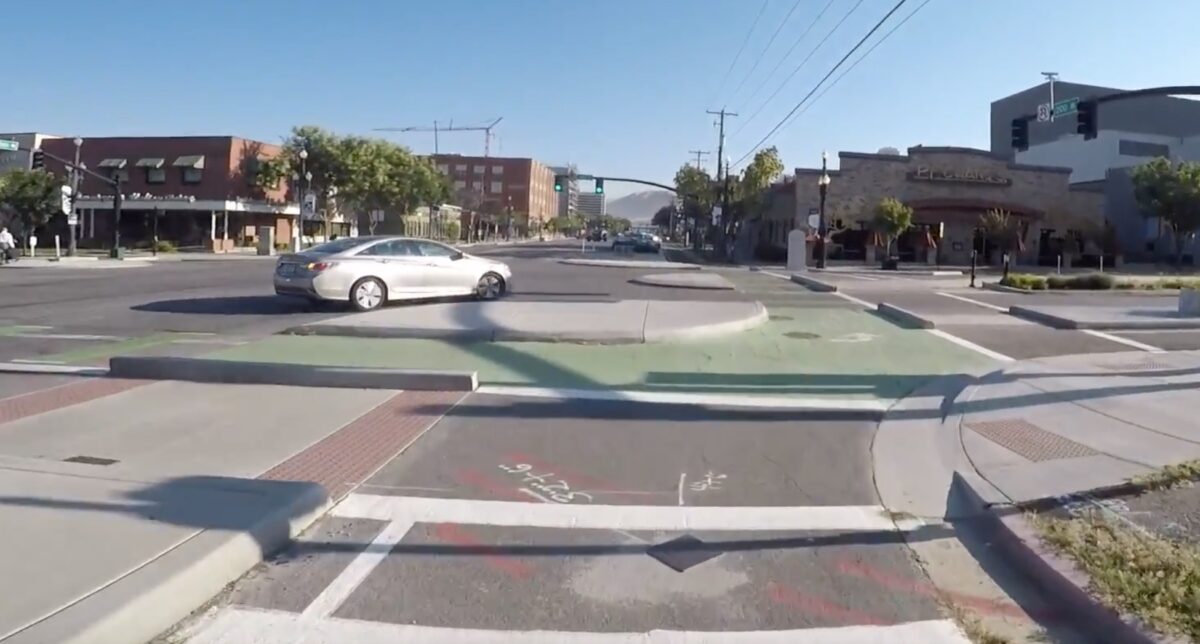
(Photo: TREC at PSU Researchers)
With protected bike lanes all the rage in Portland and throughout the U.S., a big question remains: What about intersections? After all, protection on the blockface doesn’t mean much when you come face-to-face with a drivers’ car at the intersection.
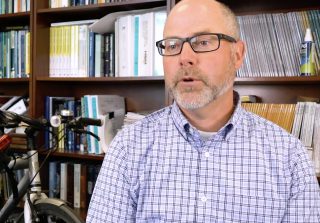
(Screen grab from TREC video)
New research released today from the Transportation Research and Education Center (TREC) at Portland State University set out to learn more about that question. What they found is that there are really only two types of bikeway designs that most people feel comfortable using, and they both include almost total separation from drivers.
The research team of Chris Monsere, Nathan McNeil and Yi Wang of Portland State University, along with Rebecca Sanders, Robert Burchfield (formerly PBOT’s head traffic engineer where he oversaw installation of Portland’s first-ever protected bike lane on SW Broadway) and William Schultheiss of Toole Design Group south to quantify the relative comfort level of a variety of bikeway design types among a variety of people.
Instead of crash data, they showed subjects helmet-mounted videos of bike lanes and asked, on a scale of 1 to 5, how comfortable they’d feel riding on it and whether or not they’d consider riding on it with a 10-year old child. A total of 277 people watched the clips during surveys taken in urban and suburban locations in Oregon, Minnesota, and Maryland. Researchers gleaned a total of 7,166 ratings from the surveys.
Advertisement
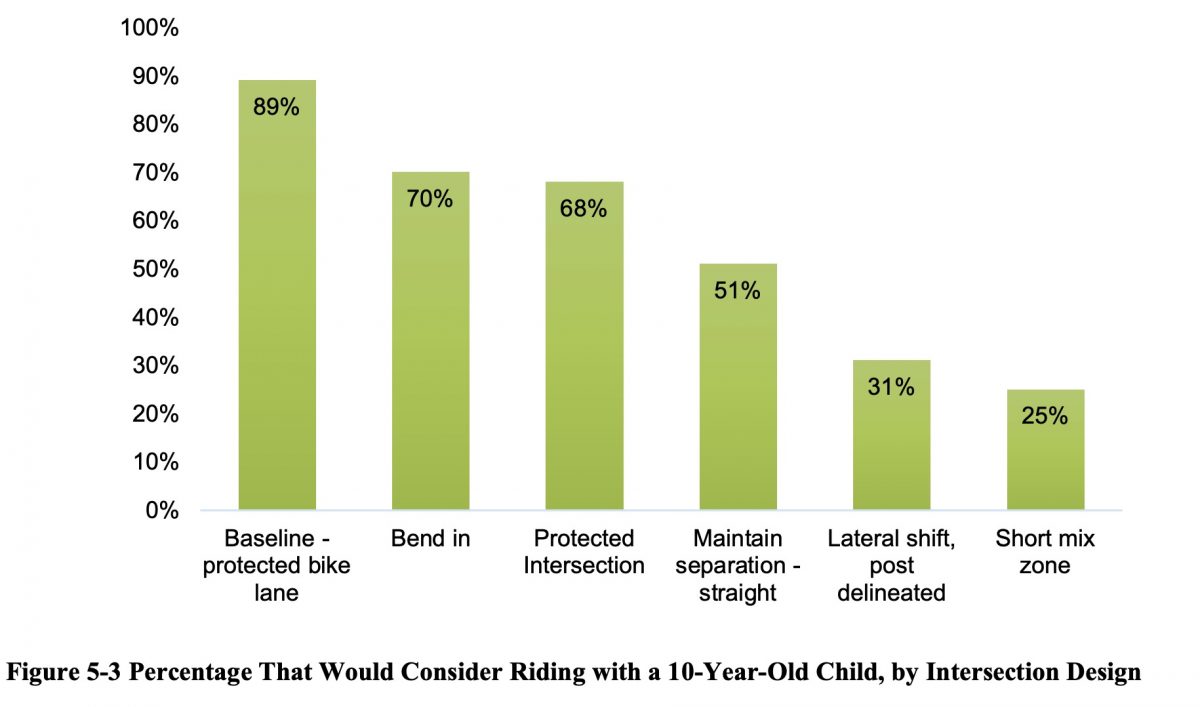
Five intersection types located in Seattle, Denver and Portland were studied: a separated bicycle traffic signal phase; a “bend-in” design that shifts the bike lane in toward other lanes; a “bend-out” design (a.k.a. protected intersection) that shifts the bike lane away from other traffic; a straight path that stays separated right up to the intersection; a “lateral shift” design that swaps the bike lane with other lanes and moves riders across the path of drivers; and a “mixing zone” design that terminates the bike lane and throws riders into the mix with turning drivers.

(Photo © J. Maus/BikePortland)
The findings show that comfort ratings plunge in places where bicycle riders are forced to mix with drivers prior to an intersection. If cities want to attract “interested but concerned” riders, researchers recommend only two of the designs: a separated bike signal phase or a protected intersection. “If you really want a bike network that’s comfortable for all ages and abilities,” said Chris Monsere from his office at PSU this morning, “It’s really just those two.”
Portland has a few bike signal intersections (NE Lloyd and Interstate at Peace Park, N Rosa Parks and I-5) and just one protected intersection (and it’s very new and in a relatively hidden location (NW 20th and Vaughn) without much traffic).
Unsurprisingly the intersections with the lowest comfort ratings were mixing zones and lateral shifts — where bicycle riders are forced to share space with other vehicle users. Mixing zones are a popular treatment at the Portland Bureau of Transportation. They just installed one on N Denver Avenue at Lombard (see photo at right).
Here’s the clip of a lateral shift design that got the lowest ratings:
Advertisement
And here’s the clip of the protected intersection (in Salt Lake City, Utah) that was rated most comfortable:
When asked the question about biking with a 10-year old, the straight protected bike lane (not at an intersection, used as a control) rated the highest with 89% of respondents saying they’d ride it with a child. Second place on the comfort rankings was a bend-in design from Denver, Colorado with 70% of respondents saying it would be comfortable. The later shift and mixing zone designs — both prevalent in Portland — were ranked as comfortable by only 31% and 25% of respondents, respectively.
There’s some data in the study that shows protected intersections result in more interactions between bicycle and car users — but is still considered comfortable because of the visibility and slow speeds the design encourages.
Another interesting aspect of this study is that researchers broke down results based on different rider typologies so you can see how “interested but concerned” riders’ views differ from “bike-inclined” (non-riders), or “strong and fearless”.
Learn more about the research and find all the downloads you need at trec.pdx.edu.
— Jonathan Maus: (503) 706-8804, @jonathan_maus on Twitter and jonathan@bikeportland.org
— Get our headlines delivered to your inbox.
— Support this independent community media outlet with a one-time contribution or monthly subscription.



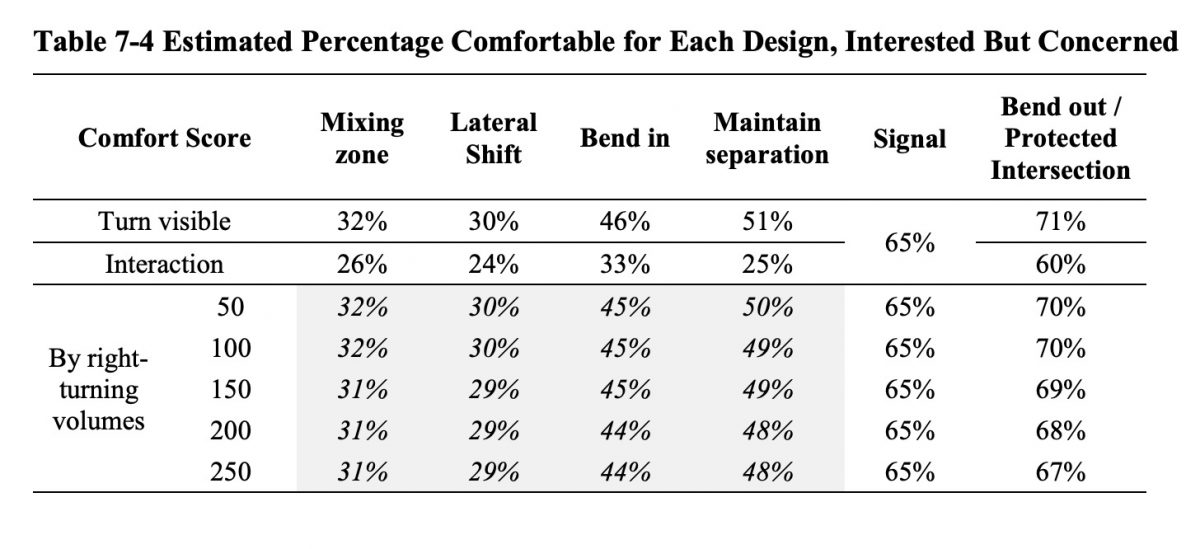

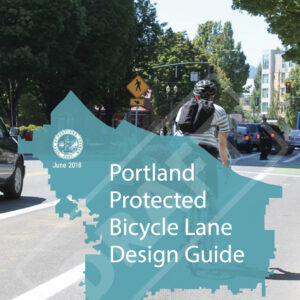
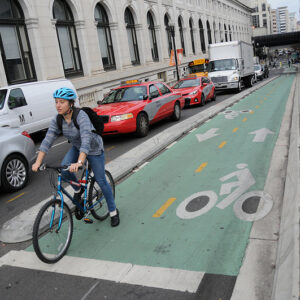

Related, but does anyone know if the work on W Burnside and 18th/19th intesection is effectively done or will there be changes to signals / timing?
Its seems more dangerous to make a left (a route probably about 50% of the bike traffic here takes) because the signals haven’t been altered to give any sort of lead time for the new infrasturcutre. If you follow a “copenhagen left” as directed by the curbs and green paint, it routes you right into traffic crossing 19th toward the stadium and seems like its inviting someone on a bike to get t-boned.
It’s so dumb how they need to jump through all these hoops of doing surveys and collecting data to even come close to choosing a design that is OBVIOUSLY better. But whatever it takes, I guess.
In other words, JUST COPY THE DUTCH. THEY ALREADY FIGURED IT OUT.
The Dutch drive differently than the Americans (not to mention less).
The Dutch also make driving around bicycles a significant part of licensing.
And yet even with this driving culture and better driver training, they still separate bikes and cars far better and far more often than almost everywhere in America. At least, on roads with speeds higher than 30 km/h (18 mph). In fact, America needs Dutch-style infrastructure even more than the Dutch do.
How much time have you spent in the Netherlands? Yes, the Dutch have physically separated bikeways, but look at the intersections in Amsterdam or Utrecht – they certainly have mixing zones there. The Dutch keep the cyclists to the right of right-turning cars, but again to my point above, Dutch drivers know how to drive among cyclists without hooking them because they know to look for them. The ‘physical separation’ there is either spatial (i.e. a different street dedicated to bikes) or a small hoppable curb, not endless bollards or the narrow chute that I mention above that exits you directly into the side of a car at the intersection itself (or slamming on the brakes on your green to wait for them rather than merging with them before the actual intersection).
My point is that protected infrastructure is not how the Dutch have solved the intersection problem, as implied in some comments. I’ve not cycled there much, but when I did I had to “unlearn” not to pass right-turning cars on the right.
I moved from Oregon to California where the cycling ‘playbook’ at intersections is different. In Oregon bikes are kept far to the right and drivers are expected to turn across shoulders, not merge into them. California teaches drivers to move to the curb 100′ in advance of a right turn, and if a cyclist is there yield to them (yeah, right – also I think they teach Californians to signal as they turn not before, if at all, but that’s an oddity I still can’t explain).
Biking in Cali you learn to signal and move left of right-turning cars and the wide unfettered roads give you that space. In Oregon you probably notice California transplants driving in your bike lanes, but when I ride in OR (about half the year) the same style is easily applied – except in protected infrastructure. When I rode in the Netherlands it was counter-intuitive to expect a driver to signal and patiently wait while you pass them on the right, but sure enough that’s what drivers do. One time I tried to signal and move left and it confused the hell out of everyone!
I’ll take a video of the protected bike lane in Cupertino that I mentioned above (I’ll slow to ~15 MPH) some late afternoon in active traffic so we can see what happens at intersections when a California driver is expected to yield to a bicyclist constrained to a 4′ wide gutter that ends abruptly at the intersection itself. (Think: bowling ball rolls down gutter after the button is pushed and the big sweeper is coming down… the McClellan Bowling Alley – yes, that’s my new name for it!).
This and every damn article about this have been the source of bitching and bitching and bitching yet nothing gets done, painted stripes have worn away and everyone who has ever lived in cities that do bike infrastructure right can now say: no shit.
The REASON the dutch drive differently is BECAUSE of the streets/bikeways. Just build it.
Build separated bikeways/emobility NOW. Simply boot the street parking from the major corridors. Somebody needs to step up and stop this madness. We don’t have until 2030 to stop using fossil fuels folks.
In the end, it comes down to severely restricting car use so that people can safely, cleanly, and comfortably move about our streetscape. We’re doing a lot of work to avoid taking this now-necessary step.
It also needs to be accompanied by behavioral controls on drivers. American drivers are an uncontrolled apex predator species. They need something above them in the food chain to feel enough fear of to control their behavior.
Except for 40-mph and above arterials (and similar) I would much rather mix with “cars” on a nice wide street than with pedestrians and wobblers in a narrow, curb-delimited chute.
As for copying the Dutch, yes, let’s, but we should start with signal optimization and legal changes before we attempt to copy infrastructure designs that will make bicycle travel a ponderous plod that bicyclists only use under threat of citation.
I have no interest in creating yet another online “free” account so I can download the complete report, but I would be curious to know the differences in attitudes between the “interested but concerned”, and “bike inclined”. Would people start out wanting protected lanes, but find them frustrating after gaining enough confidence in their riding ability? My own experience is that rather than being freeing, so-called “protected” infrastructure is confining, and has served as more of an impediment than a facility. Not that we shouldn’t have such infrastructure, but there has to be an opt-out when it just doesn’t work for everyone. First repeal ORS 814.420, then build all you want and see what gets used when use isn’t forced. Cage the cat, not the bird.
> Would people start out wanting protected lanes, but find them frustrating after gaining enough confidence in their riding ability?
Tell that to an 8-year-old kid.
I have personally been pulled over by police in several cities and states for not obeying the law when I rode on a public street instead of the adjacent path (in most cases a substandard sidewalk rather than a full protected bike lane.) I dare say many others have too. In every case the police officer was wrong on the local law, but there’s no point in arguing with someone with a gun. In every case I was given a warning, no fine or arrest, and in one case the police officer later apologized to me (as did his chief.) So I see the point of El Bicilero – for fast fearless cyclists, these types of facilities are not only counter-productive, but they can cause unnecessary hardship unless local laws are changed to allow all users a choice in facilities. There are so many places where such segregation laws exist that police are often confused by places that don’t have them, such as in Portland. (Over 80% of any city’s police, Portland included, live outside of the city limits and often have no real idea of the local laws they are enforcing.)
“Tell that to an 8-year-old kid.”
An 8 year old might enjoy training wheels for a while, and then as their skills improve will come to hate them and want them out of their way.
The 8-year-olds are who I had in mind. If they start when they’re 8, are they going to want to ride with 8-year-olds when they’re 18?
The fact that you use the term “wobblers” tells us all we need to know about your view of cycling infrastructure.
I’ll defend his use of “wobblers.”
I have no problem sharing a lane with slower or less experienced cyclists; I hang back at a safe following distance and pass respectfully when it’s safe to do so. What I don’t want is to be corralled in a chute with no way to safely pass slower moving traffic. Bike travel speeds vary much more than motor traffic speeds on a given road, and I feel like everyone should be able to ride at a pace that’s comfortable for them. I am not comfortable riding at walking speed if I’m using a bike for transportation.
We need to repeal the mandatory sidepath law, and simultaneously educate motorists that people riding bikes are allowed to use any of the travel lanes that meet their needs.
Could. not agree more–any building of bike facilities should NOT be accompanied by a restriction on roadway use by cyclists. We need “training wheels” facilities for riders without skills or confidence but we shouldn’t force every human-powered cyclist onto them. I’m gettin g older and slower but still know how to comport myself in traffic and don’t want to be corralled. Want to try how badly a “corral” can be? Ride the 2nd Ave bike lane in downtown Seattle–believe me, you’ll only want to do it once.
The facility shown above has enough space to pass a slower rider. I’ve passed slower riders and drunk pedestrians on the new stretch of Halsey in Gateway. I much prefer it to the old configuration.
“What I don’t want is to be corralled in a chute with no way to safely pass slower moving traffic.”
Give me a break. The mandatory side path law is not enforced in the Portland area.
You bring up this tired rebuttal every time.
I’m not afraid of a traffic citation. *None* of the traffic laws are effectively enforced in this town. The issue I have is that if I am involved in a collision with a motor vehicle when I’m operating outside the mandatory infrastructure, the motorist’s lawyers will use that to argue denial of damages to me. And in our courts, it will likely be a successful argument.
given that the alternative is a few seconds delay in a protected bike facility i believe your absurdly hypothetical fear is inauthentic.
Huh. I would have thought it would have been my use of scare quotes around “protected”, or use of words like “chute”, or “confining”.
Maybe “wobblers” sounds too insulting; what I mean is “unsteady novices”. I find it very interesting that “Nix the Mixing” is part of the title of this article, yet the seeming thesis is that we should trade one kind of mixing for another. In my personal view, mixing experienced commuters, pedestrians, skateboarders, scooters, and 8-year-olds (I have an 8-year-old, and I wouldn’t put him in/on any of the protected infra I’ve yet seen, other than a MUP) in a protected bike lane of the variety where there is no room for the slightest error, or, dare I say, “wobble” unless everyone goes only as fast as the slowest person present, is less desirable than mixing with slow-moving cars on, say, a downtown street. To me, the place for separated infrastructure is where we already have it, to some extent—parallel to freeways like 205 or 26. We all know the trouble we’ve had with that kind of separated infrastructure, though.
“You’re just bringing your windshield perspective, scorcher mentality to the bike lane—you need to take the advice we give motorists and just slow down”, I hear some of you saying. Maybe so—and when I encounter toddlers/walkers/joggers/doggers/etc. on the MUP, I do slow down by about 85-90%—but I have a desire/need to get where I’m going just like everybody else. What would we deem an appropriate travel speed on any given street? Should there be different speed limits for different vehicle types? Or should we only have different speed limits for different roadway/infrastructure types? Should we tell drivers that “20 is plenty”, but tell bicyclists on the same roadway, “8 is enough” (heh, get it?)? If there are different speed expectations on different “roadways”, should we prescribe which roadways certain users have the right to use?
I know it’s fallen completely out of favor/fashion, but part of me chuckles at the irony (maybe—I’m still unclear on what constitutes true irony) of needing protected intersections because we insist on keeping bicyclists on the far right, out of the way of motorists, rather than follow (trigger warning!) vehicular principles that completely avoid right hooks. I will stay in a bike lane OR merge with straight-through traffic depending on my read of each individual situation, but a protected lane would remove that choice and put me at the mercy of infrastructure and driver attention every time.
So really, I’m not saying my 8-year-old kid and my 80-year-old dad should just harden the f up and keep it over 15 mph on the street with cars, but I might be saying there could be times I don’t want to worry about being trapped behind or attempting to pass either one of them. There might be times I don’t want to negotiate with bus-stop waiters, or make a “Copenhagen left”, or ride on slippery paint through gratuitous chicanes, or be deemed to be traveling at “a high rate of speed” when I’m going half the speed of the cars 3 feet away, or worry about stopping at every driveway because I can’t move to a more leftward position, or mixing with pedestrians at every protected intersection.
I might be saying I’d like a legal choice to use “bike infrastructure” or not, or to see us build “bike infrastructure” that was as wide as the variety of its user profiles and provided enough room to maneuver (perhaps by insisting that there be zero on-street parking anywhere there was “bike infrastructure”, but I know, half a loaf…), or build “bike infrastructure” that wasn’t merely to keep bicyclists out of the way of drivers…
Comment of the week!
Vehicular cycling–like buses, it’s something versatile, useful, with infrastructure that’s already in place, and gets, like, NO respect!
I’m a wobbler, by choice. It makes drivers think they need to give me more room. Also, I’m in no hurry. I leave on-time for my destination, or I arrive late. And I look at all sorts of scenery along the way.
I think people should be able to pass me, but I never feel an obligation to pull over. Your speed is not more important than mine.
While I want to allow people to pass me, I also don’t want people bringing their car behavior into the bike lane. I don’t want to share the bike lane with people on racing bikes passing me at over twice my speed.
If we want to follow the best practice of big bicycling cities then we’re not going to have the same kinds of bicycles on the road that we have now. Amsterdam’s streets are not lined with sleek carbon fiber models zipping through traffic. The average bicycle speed there is 8 MPH. They have a mandatory sidepath law. And most of us wish we could be more like them.
“Your speed is not more important than mine.”
I agree, but then you write…
“I don’t want to share the bike lane with people on racing bikes passing me at over twice my speed.”
Why is your speed more important than mine? I safely pass people at twice their speed without incident all the time. On other days when I’m crossing the Hawthorne and enjoying the view I get passed by people going much faster than me. No problems. If one is going to use a shared space one has to assume that people are going to use it differently. We don’t all have the same set of circumstances.
My commute is a long ways and some days I go from after school meeting directly to my next obligation. I don’t have the option of smelling the roses along the way. My only other option is to drive.
“I safely pass people at twice their speed without incident all the time”
in the bike lane? if so, that’s very rude.
Usually a bit into the car lane or on the white line, depending on the width of the bike lane and their position within it. In other words, I pass them safely using common sense.
The comment you responded to focused on passing in bike lanes.
Recently I rode on McClellan Rd in Cupertino, where 15-yo Ethan Wong was killed by a truck that right-hooked him. In addition to ample ‘greening’ of bike lanes (the panacea), they created a physically separated bike lane. While riding in this facility I was right-hooked more often and with more closeness to collisions than I’ve had since moving to California.
In one section there were city workers clearing detritus next to the sidewalk, and they placed a sawhorse across the bike lane – no cones or any other warning and no way of knowing about the blockage until a block into the ‘jailed’ segment. They were puzzled when I placed the sawhorse onto the sidewalk to continue on and asked me why. I asked why they would block the bike lane and not the sidewalk, and how would they expect a cyclist to choose either the street or the sidewalk without any warning until traveling within this 4-foot wide walled width at potentially 25-30 MPH. They were baffled.
Needless to say, I’m seeking alternate routes now. For the class of cyclists that some people call “fast and fearless”, this type of facility can be downright dangerous – and technically since we in California have an exception from the bike lane “anywhere a right turn is permitted”, I’m not sure we’re any better off than Oregonians are with 814.420.
I note that the best solutions are typically the most expensive ones, both in materials and space used in the right-of-way. Does Portland even have an intersection as wide as the one in Salt Lake City shown in the video? I know East Portland enough that 122nd at Division is narrower, and that’s among the widest in Portland, not to mention far busier.
I’m sure if we were like the Dutch and didn’t spend trillions on useless foreign wars and preparing for WW3, we too could afford to build protected bike lanes, ocean dikes, freeways, and river tunnels like they do. Unfortunately, we as a society have spent the last 150 years electing presidents and congresses who seem to love war and supporting the military-industrial complex over building boring infrastructure.
This is an important point. Roadway widths in Salt Lake City are 130 feet wide! Many of Portland’s five lane arterials are 66′ feet wide, less than half that. Some get up to 72 but generally there is a lot less space to work with unless they can purchase adjacent right-of-way (businesses and homeowners are generally not psyched about that).
It might have been a more useful comparison for us portland-based folks if they had used a clip of a Portland protected intersection (like Burnside/19th) but that probably wasn’t ready when they conducted the research. Agreed with a later commenter that I didn’t like it for heading left onto Alder St and into downtown, I’ll continue to take the lane and turn left. But I also recognize that I’m not the category of rider that infrastructure was built for.
I knew that SLC streets were pretty wide, but 130 feet is beyond my expectations. Outer Division & 122nd are 90 feet wide on average, as are a few other East Portland arterials, but most are 70-80 feet wide. I believe 82nd is mostly 66-70 feet wide, but there are a few very narrow sections. Powell from 50th to 82nd has a few remaining sections of 120+ feet from the Mount Hood Freeway days, but much of the land has since been sold to developers.
Always with the “why it won’t work here”argument. Yes ALL original older Morman cities in Utah are platted with extremely wide streets (amazing as they were done before the motor vehicle!) but the segregated through-design is common in The Netherlands where, trust me, few streets are as wide as SLC! Yes, for some streets it won’t work but for many (most?) American roads this argument doesn’t hold water. The “why it’s different in America and why we can’t do it here” rationalizations are endless but when looked at closely are mostly illusory. American roads have more than sufficient space to lay out bike specific infrastructure. What’s missing is not space but will.
I agree with you about the will. There are lots of cities like SLC on the East Coast – For example, DC, Charlotte, Miami, and suburban areas surrounding most US cities – that have extra-wide rights-of-way. If anything, inner Portland’s narrow streets is an outlier among US cities.
As for the Netherlands, for every well-preserved or rebuilt medieval/Baroque city like Amsterdam, Maastrict, or Haarlem, there are several other cities that have been so destroyed in WW2 that they really do have superwide boulevards through then center of the city: Rotterdam, The Hague, Eindhoven, & Heerlen for example. And like American cities, most Dutch cities have sprawling freeways in their over-built suburbs, where the poor and immigrants tend to live, away from the tourists.
thanks for the reality check! BP is full of posters who don’t understand this!
I’m with El Bicilero on taking my chances along cars and other traffic instead of a multitude of pedestrians and other non-vehicular users, they’re drivers normally anyways but are more erratic once outside the car. I’ll never lend my support to anything that has a square curb, those are designed to help autos “bounce” back onto the roadway and unless one can bunnyhop well enough it’s going to take down a cyclist almost every time. While I see the calls for more bikeways being necessary we need to make the distinction that’s for urban users in a city landscape and does nothing for someone like myself who rides 25 miles in the AM to work and a large majority of it is on rural-ish roads.
I don’t think there’s a lot of talk about putting channeled sidepaths on rural roads. And if they did, how many people do you think would be using it and also be obstructing your high-speed commute?
Just curious, but in your opinion what’s the difference from a paved rail-trail near a highway and a rural sidepath? And how are the bike paths along Marine Drive different?
@JBye, I wish it was a high speed commute! More like 14-17 max to work. The problem I have with th e cycling community is that separated lanes are touted as the panacea to the car/bike issue. What I find is that mentality morph’s into many drivers perspectives that cyclists now only belong on those parhs and we’re now even at secondary level in their head. Plus so much cycling doesn’t take place in just the city. More on this later.
“protected bike lane on SW Broadway”
Just another broken-record post pointing out that there is no such bike lane there and that the term “protected” continues to be misused.
“Here’s the clip of a lateral shift design that got the lowest ratings:”
Car is obstructing the lane here forcing the rider to squeeze into a smaller lane closer to car traffic.
“And here’s the clip of the protected intersection (in Salt Lake City, Utah) that was rated most comfortable:”
This video does not show an active conflict with a car, so of course will be selected as the preferred intersection.
These videos are not equivalent comparisons.
When I envisioned myself going through these intersections I thought of the worst case scenario where in the lateral shift scene the station wagon (now called SUV) driver sideswipes me as they turn into the lane bouncing me to the right road shoulder, and in the protected scene I get hit with the grill of the car and possibly run over.
I chose the lateral shift scene. Unless you add separate signal timing to the protected one so there’s never a conflict then I’m going to be way more nervous than I would be of getting sideswiped in my own lane.
I’m glad you caught that. In the ‘unpopular’ clips, the cyclist is too far right (presuming this is the POV from the rider) and not positioning themselves in their projection of travel (relative to the car flow and lanes). That positioning is also the reason California legalized leaving marked bike lanes wherever a right turn is authorized (CVC-21202).
And SLC blocks are 600 feet long, compared to 200 feet in PDX!
Traffic there is like drag racing between signals.
They do have MAX-like light rail, and fairly frequent heavy rail for the many miles between Ogden and Provo–powered by filthy old diesel locomotives.
Also very bad air pollution stacked up against the Wasatch Mountains, especially in winter.
Is the horribly overbuilt bike roundabout at SE Mitchell and Milwaukie considered a protected intersection? This former ‘vehicular cyclist’ is becoming more and more an advocate of protected infrastructure as I observe SO MANY people driving in the bike lane on Willamette (I was nearly clipped from behind last night on my way home and I was solidly in the middle of ‘my’ lane). However we MUST be designing for the volume of cycling we want to see, not for the volume we currently have. Back to the horrible roundabout in my neighborhood — I’ve used it once. It’s narrow, confining, it makes me slow down when I don’t need to, and it forces me to go a direction I don’t want to go. There’s no way to for more than 2 cyclists at a time to be in it and you definitely couldn’t pass someone. If that’s what PBOT is building, I want none of it, though I also really don’t want to get hit while in the bike lane either.
Vancouver, BC now has a few protected intersections. Using them is really nice and just seems so natural now. There is no sense of being confined or anything like that. It feels more like no longer being disenfranchised.
They should present a video to people of riding in the trash-filled “protected” bike lane on 2nd Avenue and nearly getting hit by turning cars & pedestrians every block vs. riding in the middle lane of 4th (like you used to be able to do on 2nd).